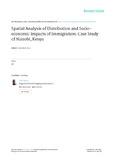| dc.contributor.author | Ogola, DPO | |
| dc.contributor.author | Kiema, John Kyalo B | |
| dc.date.accessioned | 2016-07-01T13:51:28Z | |
| dc.date.available | 2016-07-01T13:51:28Z | |
| dc.date.issued | 2015 | |
| dc.identifier.citation | Sci-Afric Journal of Scientific Issues, Research and Essays Vol. 3(11), Pp. 819-829, November, 2015 | en_US |
| dc.identifier.uri | https://www.researchgate.net/publication/286441118_Spatial_Analysis_of_Distribution_and_Socio-economic_Impacts_of_Immigration_Case_Study_of_Nairobi_Kenya | |
| dc.identifier.uri | http://hdl.handle.net/11295/96714 | |
| dc.description.abstract | Increasing globalization trends have made migration a key element in national and international deliberations
worldwide. Mapping of immigrant issues has therefore gained prominence in many parts of the world. In Kenya
the management of foreigners or aliens is one of the core functions of the Department of Immigration Services
with the mandate of enhancing security and socio-economic development through policy and management
strategies targeting immigrant populations. However, due to inadequate use of available technology a number
of potential datasets still remain largely unexploited including data on visas and work permits, border-post data
and passenger surveys at international airports and seaports. This study proposes a spatial approach to enable
tracking, analyses, visualization and management of alien activities. This entailed the geo-coding of immigrant
residential addresses and linking this with their respective attributes to enable input, storage, manipulation and
analysis using appropriate spreadsheet and GIS software. The results were visualized using various maps,
charts, figures and tables. The study demonstrated that migration and development are closely related and
create impact in various perspectives and proportions. Furthermore, geospatial technology has great potential
for organizing, manipulating and analyzing migration data and information and can enable the department to
use a variety of maps and documents to interpret and better understand immigrant activities, including major
patterns of migration; settlement patterns and changing environmental preferences. | en_US |
| dc.language.iso | en | en_US |
| dc.rights | Attribution-NonCommercial-NoDerivs 3.0 United States | * |
| dc.rights.uri | http://creativecommons.org/licenses/by-nc-nd/3.0/us/ | * |
| dc.subject | Spatial analysis | en_US |
| dc.subject | GIS | en_US |
| dc.subject | Foreign Nationals | en_US |
| dc.subject | Geo-coding | en_US |
| dc.subject | Immigration | en_US |
| dc.title | Spatial Analysis of Distribution and Socio-economic Impacts of Immigration: Case Study of Nairobi, Kenya | en_US |
| dc.type | Article | en_US |



